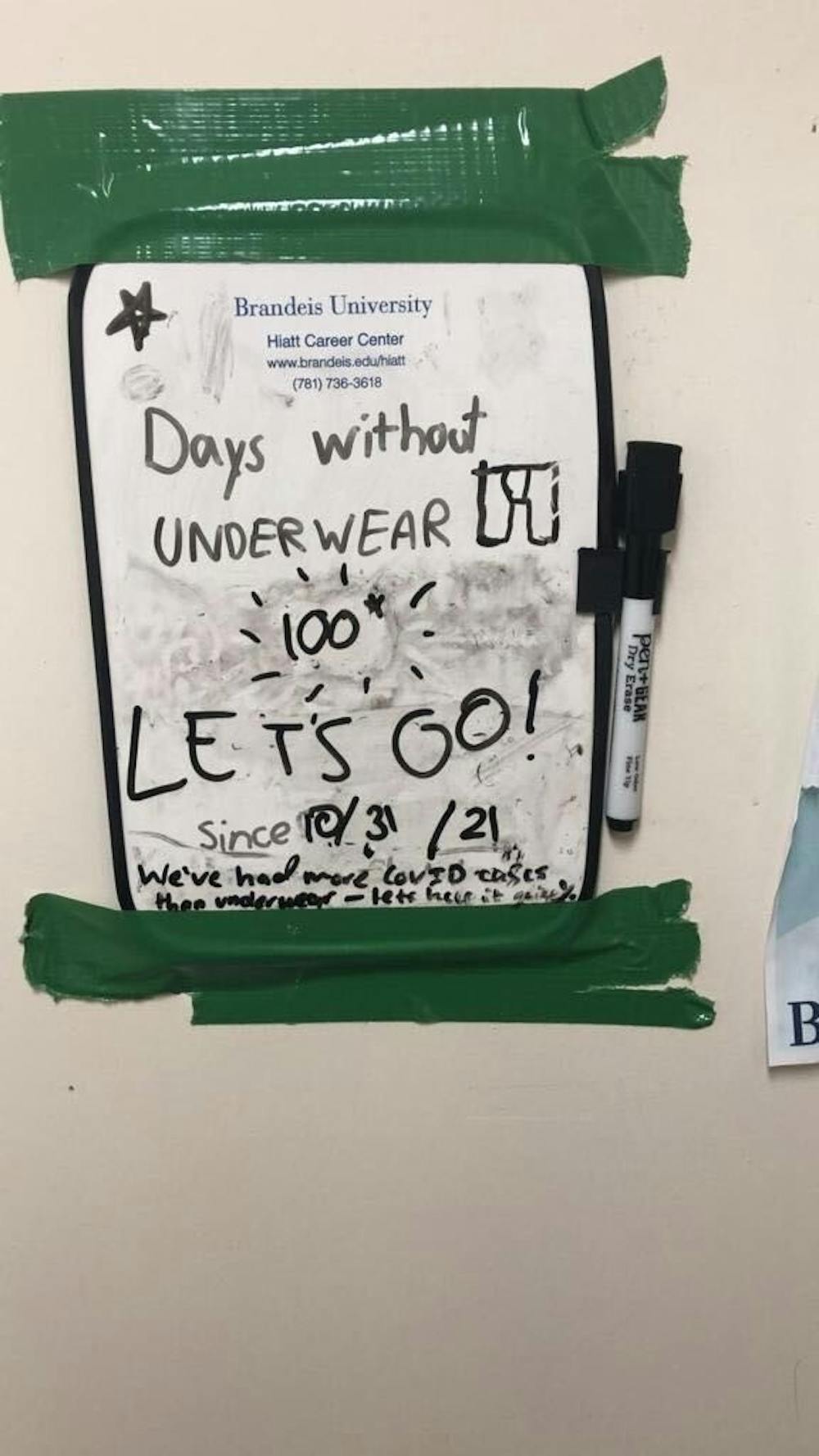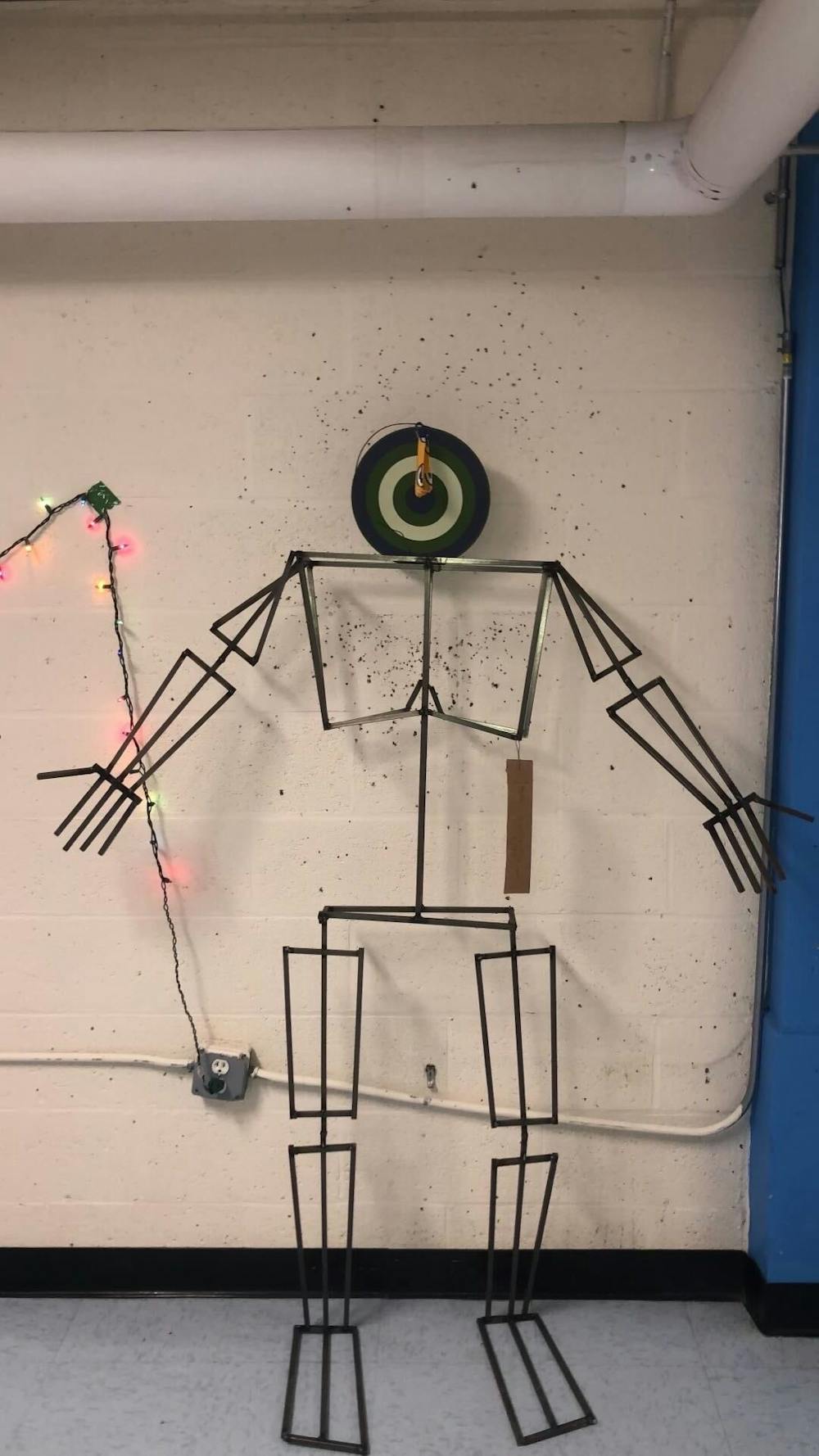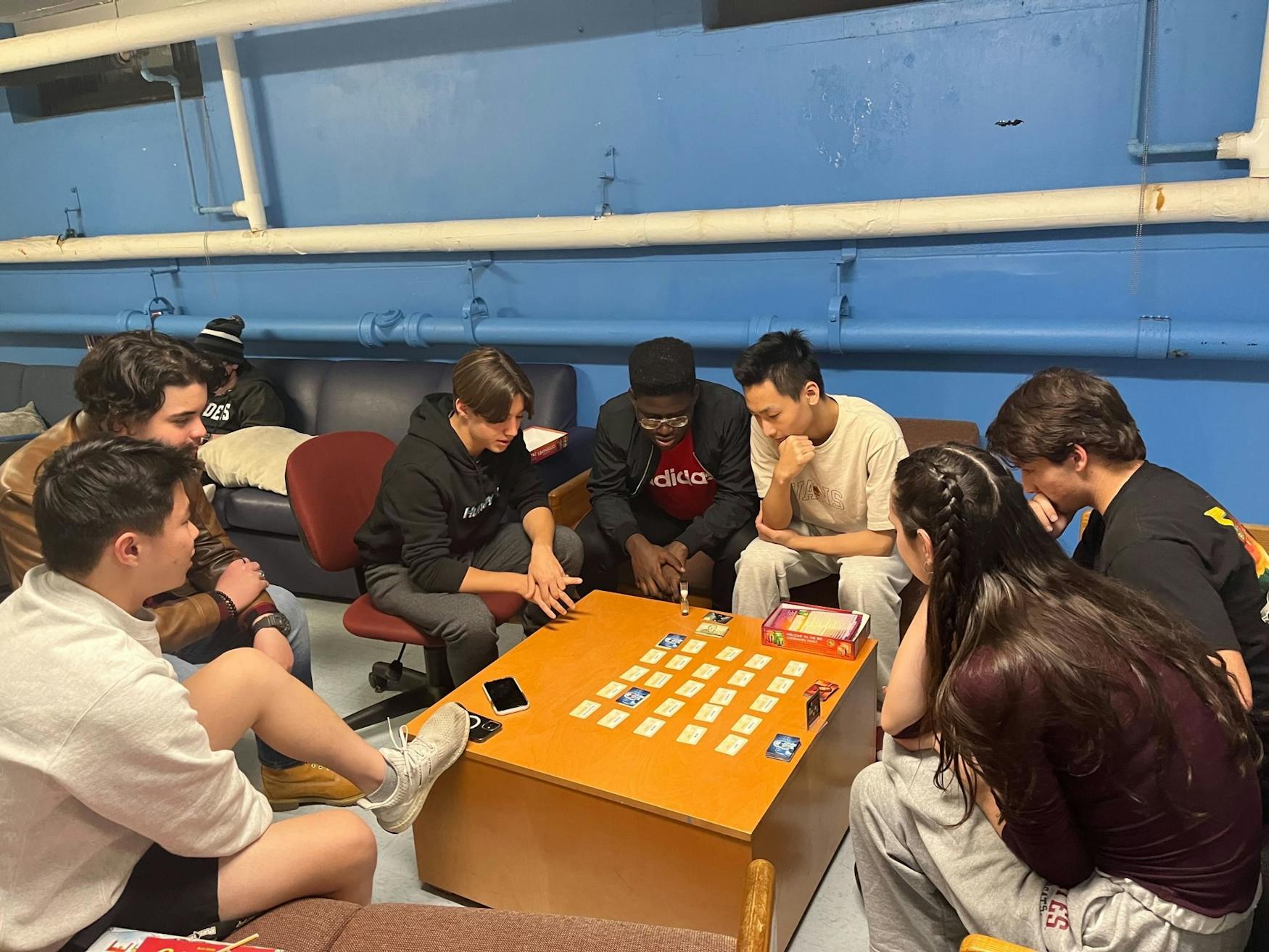The real freshmen of the Shapiro basement
There’s no better joke at Brandeis than its housing. But when 16 first-year boys found themselves living together last year in a retrofitted basement with less than ideal amenities, they found strength in their numbers.
The walk down from the front doors to the basement floor of Shapiro Residence Hall is surprisingly typical of any dorm in Massell Quad — at least in comparison to the space it leads to. The basement isn’t home to killer clowns or secret passages, but it’s still a basement. In the dim light from the tiny windows that are few and far between, you’ll find blue walls, tile floors, a single bathroom fit for two, and 16 first-year boys lurking in the dark.
When Braedy Guenther ’25 followed his orientation leader down the stairs — below ground — on move-in day in fall 2021, his first reaction was, “Crap, this isn’t going to end well.” His senses weren’t entirely off; he walked in to find pipes everywhere and a puddle of water on the floor. He sent a picture of his tiny basement room to his soon-to-be roommate, Jonah Ellis ’25, who up until that point hadn’t realized he was going to be living out his first year at Brandeis in a basement.
Gabriel Abreu ’25 had a similar reaction upon moving in. When his orientation leader opened the door to a pipe-filled room with a single, tiny window, he thought, “Okay, it’s like a little submarine. Cool.” He, like Jonah, hadn’t known about the basement housing, either.
First-years enter Brandeis with varying levels of information regarding their housing. Students receive a building, room number, and the name of their roommate, but nothing more, and the Brandeis website provides only a brief overview of what each building includes. Many don’t learn anything more beforehand, such as Jonah and Gabriel, and all Eli Fighter ’25 knew was that his mom, a Brandeis alum, had enjoyed her first-year living experience in the 1980s.
Andres Zalowitz ’26, on the other hand, had learned early on from a Discord server for admitted students what he had in store for basement living. “You just kinda hear things, I guess,” Andres said. “And the general consensus was like, this is $600 less than all the other ones. Why is it $600 less than all the other ones? It must really suck.”
New and better living
Although it’s currently known for its sweltering heat and complete lack of handicap accessibility, Shapiro Residence Hall was not always the infamous dormitory it is now. Completed in January 1952, the $500,000, female-only Hamilton A was the first dormitory built in what was then called the Hamilton Quadrangle as part of a campus-wide building initiative. While it may come as a shock to its current residents, the building was considered by the University to be “one of the most modern college dormitory buildings" by the Brandeis Bulletin at the time of its construction, and it was described by the Justice as “new and better living” in comparison to the housing that was already provided by the University. Up until Hamilton’s construction, the University did not have enough housing to house all their students, something which was at least temporarily remedied by the glorious new Hamilton A.
The basement of Hamilton A, with its recreation room, music room, and “fully-equipped laundry,” was deserving of its own paragraph in the April 1952 Brandeis Bulletin, but it wasn’t long before basement residents were facing their fair share of problems. In September 1954, two hurricanes swept the area, and the basements of Hamilton A and B “were flooded to their ceilings.” The basement was also described by one Justice reporter in 1955 as the “dank and unhealthy cinder-block basement of Hamilton A” — a far cry from the “glittering” new dormitory bragged about just three years prior.
In April 1958, Hamilton A was renamed the Shapiro Residence Hall after donors Esther and Morris Shapiro, thus becoming another Shapiro-shaped infinity stone in the campus gauntlet. Over the decades, though, no matter the name, basement dwellers continued to confront flooding, bugs, excess heat, and noise from the pipes. In 1983, the basement rooms were “judged to be in poor condition” and referred to as “rooms we’d rather not use” by University administration.
Given the number of first-years living there now, however, sometime in the past few decades, Brandeis’ tune changed.
A united front
Think of the Shapiro basement as the University’s Bermuda Triangle. It’s not significantly different from other dormitories, but enough problems happen in this concentrated area for it to be of note. The sheer quantity of the aforementioned pipes in both the common space and the rooms are already enough to beat out other first-year floors, but past and present basement dwellers will tell you that they’re much more than just an eyesore. Most first-years are not strangers to pipes that, according to Andres, sound as though “someone's taking a hammer to an anvil,” but there’s a rushing noise from the water pipes, and the heating pipes provide a whole separate issue.
When Andres rolls down his sleeve, you can still see the burn he got from a pipe connected to his radiator a couple months ago. “I was opening up this big window and my hand went slightly lower down than it should have been,” he explained. “There's no room for error.”
The bathroom itself is its own character. With only half of everything functioning correctly, it’s quite the sight. One sink is fine, but the other is right next to the hand dryer, which as a result is frequently activated by accident. One of the stalls is just a little too small, and last year’s “infinite flushing toilet” incident is self-explanatory. The “SSFs” — basement slang for the Shapiro shower flies — reportedly remain an epidemic, and the one bad shower has had a multitude of problems this year alone. First, it had no water pressure. Then, it wouldn’t start. Next, it wouldn’t get hot water, and then the water pressure got bad again. When in use, the same shower also makes a very loud noise resembling a marching band. Essentially, if you don’t call dibs on the good shower, you’re out of luck.
Leaks and flooding also run rampant. “It’s very unpleasant when you wake up and you swing your legs over your bed, and you put them on the floor and it's wet,” Jonah said. The pipes also burst every year, according to Zach Mayer ’25, not to mention that during an extremely cold week this past semester, the boiler burst, flooding into the stairwell and the rooms next to it.

FLOODED: Some areas of the basement are prone to flooding after rain, as this photo, taken in the basement on May 1, 2023 shows.
An incident that was especially bad this past semester was when the drinking fountain exploded, resulting in a flooded hallway on a Friday night. While waiting for the general repairman on call, Andres and the other boys all grabbed their trash cans and left them under the fountain until they filled up. Then they’d dump the water in the shower, put the trash cans back, and repeat for about an hour until facilities arrived. “That was actually the moment where the basement rallied together,” Andres said of the incident.
When asked for comment about the series of problems with the Shapiro basement’s facilities, the Assistant Dean of Student Affairs Timothy Touchette claimed in an April 18 email to the Justice that besides a water main leaking near Shapiro due to a contractor working near the building, the other problems “did not happen to [his] knowledge.” According to Touchette, “There are no outstanding issues in any residence halls, Shapiro included.”

Basement brotherhood
Although David Merges ’25 said that the basement was probably the worst place they’ll have to live in at Brandeis, he also said it was bearable because of the community that formed within it.
The basement, described as “absolute shit” by Tristan Santiago ’25 and deemed a “bit of a fixer upper” by Jonah, provided different reasons for the boys to band together. The basement set-up would not have functioned if they hadn’t held each other accountable for how their actions — or inactions — affected one another. Due to limited space in the bathrooms, for example, the boys formed a habit of hanging underwear on the pipes, but if they left them there, they started to form a less-than-comfortable living situation. To curb the problem, the boys hung up public service posters, as well as a “days without underwear” counter tracking pairs on the pipes, reminding everyone to clean up after themselves. The consequence for not doing so? “We would shame them to hell,” Gabriel explained. “Like some Scarlet Letter.”

To boot, their “town hall” meetings held every Friday added structure to basement life — it was a platform for announcements, such as those surrounding the underwear. Although over the course of their first year, the meetings transitioned from “cute” town halls held in their lounge to just, “Let’s throw a rager.”
It is universally agreed upon that the common area was what ultimately brought them together. Other basement floors, while of a higher physical quality, are just hallways. Meanwhile, Shapiro basement has its own lounge populated with couches, a TV, a massacred dartboard, a ping-pong table, and a nonfunctional mini-fridge that appeared out of the blue. It wasn’t only a place to hold town hall meetings; things started with a group chat to organize movies on the basement TV, and it all snowballed from there. Whether it was their early fall semester poker night when Marcus Sutton ’25 was elected president of the basement, the Super Bowl party, or their basement prom and graduation — most of which were organized by the basement’s party planning committee, which was primarily David and Eli — the lounge became the center of basement life.
The couches in the lounge also became a second bedroom for some. For various reasons, not excluding COVID-19 quarantines, there would be basement residents looking for a place to crash, so they’d move a couch into someone’s room or simply set up camp in the lounge and sleep. Ben Lambright ’25 spent around three nights in a row with his sleeping bag on top of two couches put together and David joked, “Another unifying factor [was] taking pictures of me sleeping.”
But something about the basement had to be unique. Students hang out in places like the Shlounge — campus slang for the Shapiro Lounge — and have certainly slept there, but this basement dynamic isn’t found elsewhere on campus. “I think it definitely helped that we were all freshmen, too, because we were all looking to make friends,” Jonah said. Furthermore, the basement’s common area was right off of their rooms, which allowed the boys to socialize in a way they wouldn’t have been able to on other floors. There was always someone in the lounge, either from their floor or another, which had its benefits, although it did get to the point where they hid the HDMI cord to prevent strangers from taking over the aux. Such borderline ridiculous instances ran rampant; there was also Byron, a six-foot-tall metal statue that lived alongside the boys in the basement. “I just woke up one day and he was just standing outside my room,” Shakthi Kodeswaran ’25 remembered. “I was like, ‘Who is this?’”

BYRON: Byron, a metal statue of mysterious origins, was a familiar figure to basement residents.
Ultimately, the year had to come to an end, and in some ways, it was a relief to move on. Namely, the poor quality of living wasn’t going to be missed. Losing the basement wasn’t the end of the world — even without poker nights or shower conversations, the relationships they built, while fostered by the basement, didn’t require that shared space. This year, the boys are scattered in other living spaces across campus, but say they’ve remained close. “Each of us went through a lot of firsts in the basement,” Eli said. “It was a safe space for all of us to explore college and figure out who we are in college, because it’s a big transition.” The transition from a senior year lost to COVID-19 to the first year of college is intimidating, but as Eli said, it helped that it was an experience they went through together. “With people who are also going through it … it made it feel less isolating.”
A common sentiment on campus regarding first-year housing is, as Tristan put it, “As long as you don’t get the basement, you’re fine.” But for last year’s Shapiro basement boys, the random assignment was the opposite of a curse. “Going into college, I didn't imagine I would get to know all of [these] guys like that,” Tristan said. “I know we all have our separate friends and stuff. But I know we can always go back to each other if need be.” This support system created in the Shapiro basement might have initially been caused by poor living conditions, but the disasters in the basement proved to form a powerful bond. If they had lived in any other configuration across campus, it may not have happened.
Sometimes, you just get lucky.



Please note All comments are eligible for publication in The Justice.